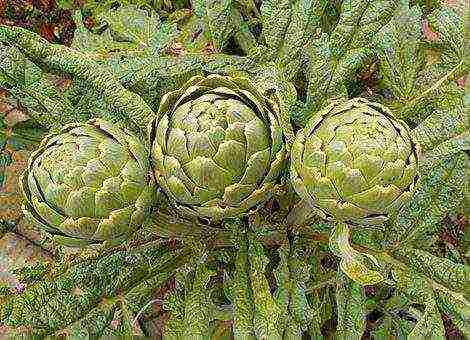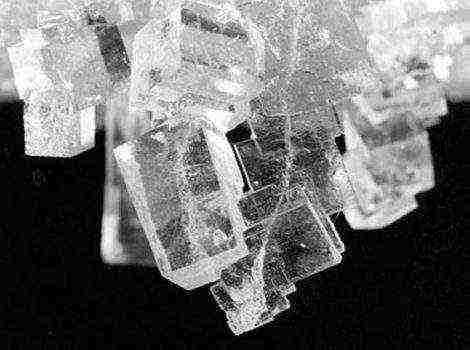Content [show]

Cypress is a small coniferous tree that was brought to our country from North America. The height of the plant is no higher than a meter, so it can be grown both at home and outdoors. Let's take a closer look at how the planting and care of a cypress is carried out, what types of shrubs are, and also how reproduction takes place.
Brief description of the shrub
Coniferous, evergreen cypress trees grow in North America, China, and already in our country. Wild plant varieties can grow over 60 meters in height. Varieties for cultivation in the country grow up to 1.5 meters.
The cypress has a slender trunk with a dark brown bark, a conical crown, branches unevenly located on the trunk with dark green or gray-green foliage. Young leaves of the shrub look like needles, and more mature ones - flattened scales.
In the first year of the bush, it is covered with small, tightly gathered cones. Each scale hides several seeds under it. The Japanese cypress variety can withstand very severe frosts. It is important - to protect young bushes from the cold in winter anyway.
In order to successfully grow a shrub in the country or at home on a windowsill, it is important to choose the right type and variety, as well as to properly care for it.
Shrub varieties
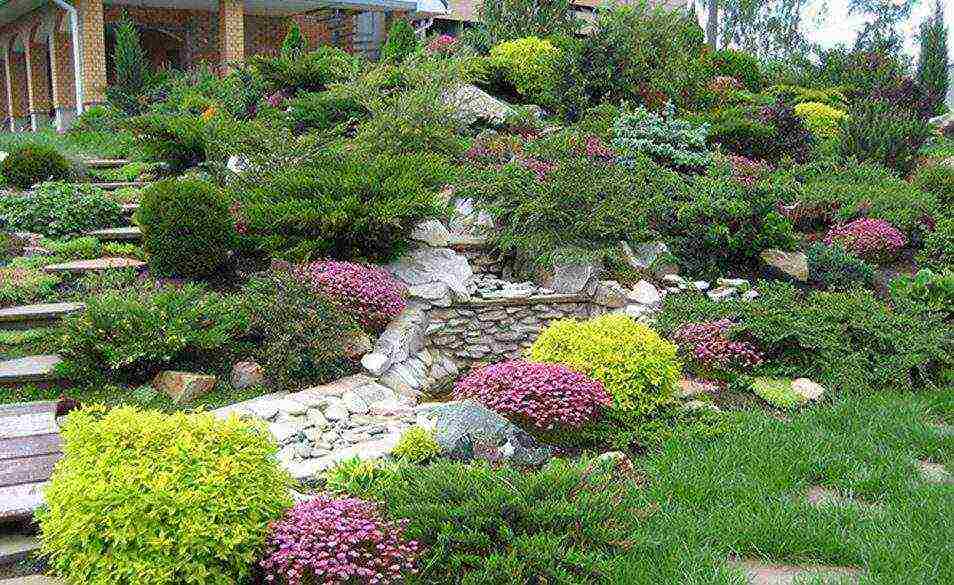
There are seven types of cypress. On the territory of Russia, you can most often find a variety of Japanese selection, which in turn is also divided into many subspecies.
The most popular garden cypress varieties are the following:
- Nutkan shrub grows slowly, tolerates cold well, but severe frosts can slightly freeze the rhizomes. This variety is considered the most beautiful of the weeping coniferous shrubs.
- Dull cypress loves to grow in fertile soil with high levels of moisture.This variety grows well in areas with cool summers and mild winters.
- Lawson's cypress. Such a coniferous plant is loved by gardeners. But it is afraid of severe frosts, as it may die. Therefore, it is difficult to grow it in our climatic conditions. But, if you decide to grow just such a variety of shrubs, reliably protect it from severe frosts, or grow it in a tub at home.
- The pea cypress grows in fertile soils and sunny places. This variety is beautiful, unpretentious in cultivation and firmly endures frosty winters.
These types of cypress have their own subspecies. The pea cypress grows up to 30 meters in the wild. It has a brown bark with a red tint, an openwork conical crown, branches spread horizontally. The needles are gray-blue, the cones are small, yellow-brown in color. The most popular are the following types of pea cypress:
- Boulevard bush grows up to five meters. It has a pin-like tip with silver-blue needles up to 6 centimeters long. The seedling does not grow very quickly, but every year it becomes 10 centimeters taller. It does not have high winter hardiness, so it is best grown in warm places;
- up to 5 meters, the filifer cypress grows. It has a wide conical crown, sagging shoots, gray-green needles;
- the undersized nana shrub has a pillow-like crown. It grows no higher than 60 centimeters. It has small, scaly, bluish needles.
Lawson's cypress grows up to 79 meters if it grows away from civilization. It has a conical crown, which expands downward, the branches fall down. The bark of a reddish-brown shade cracks into plates. The needles are green with a shiny sheen. The most popular varieties of this type of cypress are the following:
- the Elwoodi plant has a conical crown up to three meters in height. The bush has straight branches, blue needles. It has oval cones of brown color with light reflections;
- Blue Sepris plant grows up to 3.5 meters. Also has a narrow pyramidal crown. It has a brownish-red bark, small blue needles;
- the flatchery cypress grows up to 8 meters. It has a columnar crown, branches of a green or blue tint directed upwards, which are cast in purple hues in autumn.
The blunt cypress is of Japanese origin. He is the owner of a smooth, light brown bark with dense branches that hang slightly at the top. The needles on top are yellow-green or green in color, and below they are covered with clear white stripes. The most popular varieties are the following types of blunt cypress:
- bushes of the Albopikta variety grow up to two meters. The branches are horizontal with yellow-white tips, and the needles themselves are green;
- the Sanderi variety has horizontal or straight branches, which have an uneven thickness and fork-shaped branches. The needles are blue or green, and in winter, their color turns to a purple-violet hue.
The cypress tree has a height of 25 meters. It has a narrow conical shape, brown bark, dark blue or slightly light needles, which have a peculiar smell. This type of cypress has the Konica variety, which has straight, blunt branches and subulate, bent needles at the bottom.
Nutkan cypress can grow up to 40 meters in the wild. It has a graceful, dense crown, gray-brown peeling bark. A fan-shaped pattern is formed from the twigs. Dark green needles smell unpleasant. Bears fruit in spherical cones.
The most famous varieties of this type of shrub are Pendula and Glauka. The first variety is drought-resistant, grows up to 15 meters, has shiny dark green needles on sagging shoots. The second variety grows up to 20 meters, has thorny needles with small scales, blue or green.
In addition to all the types described above, cypress can be sidewalk and Formosan. Each variety, in turn, is divided into subspecies.
Features of planting a bush
It is important to plant cypress in partial shade, on the territory, without stagnation of cold air. It is also necessary that the site is well lit.
The soil should be nutritious, well-drained, loamy and not calcareous. The shrub is planted in April, when the soil has already warmed up well after wintering. But, it is important to make a planting hole for a cypress in the fall so that it can settle. A hole is dug 90 × 60 cm in size. Cover the bottom of the hole with a twenty centimeter layer of broken brick and sand. Mix turf soil with humus, peat and sand. Fill the hole halfway with the resulting mixture. The substrate will turn over during the winter, settle down and will be ready for planting in the spring.
The bushes should be planted at least one meter apart, since the cypress tree has a horizontal root system.
The landing procedure itself is carried out as follows:
- Purchase cypress saplings from a specialty store.
- Water the planting hole with plenty of water.
- Pour the earthen clod of the seedling with the root solution.
- Place the seedling in the center of the hole and carefully cover it with soil. Be sure to add nitroammofosk (300 grams) to the soil.
- When planting, it is important to position the seedling so that its root collar is 10 centimeters above ground level.
- Water the planted bush well.
When the soil settles a little, fill the hole to the end with earth so that the neck is at ground level. Mulch and tie the seedling to a support.
Features of plant care
The cypress is not picky in care, but special care is carried out during the first four years after planting in the ground. The crown of a young shrub is too vulnerable in summer and winter. It is important to water the plant correctly, feed it, cut it, and cover it for the winter. Make sure that it does not die due to extreme heat or frosty weather in winter.
How to water
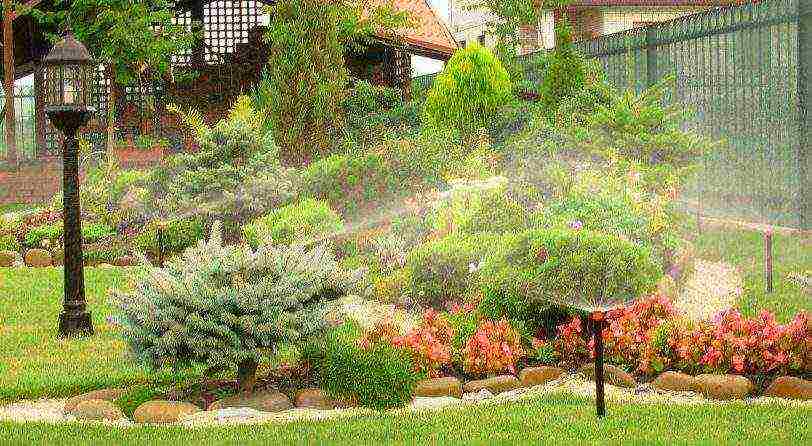
It is important after planting or transplanting a seedling to a new place, be sure to water it. Make sure that the topsoil does not dry out. The bush is watered three times a week. Cypress will grow and develop only in moist and loose soil. In hot summer, spray the crown with warm water in the morning or evening.
During the first year after planting, the crown must be protected from strong sunlight. Try to maintain constant humidity in the air by sprinkling or spraying regularly. Before preparing the soil for wintering, it is important to water each bush abundantly with 20 liters.
We make top dressing
21 days after planting the seedlings in the ground, you need to fertilize the ground with a complex mineral fertilizer.
After another 21 days, the soil is mulched with organic fertilizers. At the end of summer, the feeding procedure must be stopped.
According to this scheme, it is recommended to feed cypress bushes within four years after planting. If the soil on which the cypress was planted is poor, heavy and loamy, you will need to spend more energy and fertilizers to care for it.
It is no longer necessary to feed adult trees, but the soil around the bushes still needs to be mulched with humus or compost.
Pruning rules
Crown formation is carried out in the spring. In the first year, pruning is usually not carried out. In the second year after planting, the bushes are carefully trimmed. Crowns of any shape or shape are formed. Pruning is carried out with special tools that are pre-sharpened and disinfected. The bushes are trimmed with long scissors designed for special pruning of the crown of coniferous crops.
Protection from pests and diseases
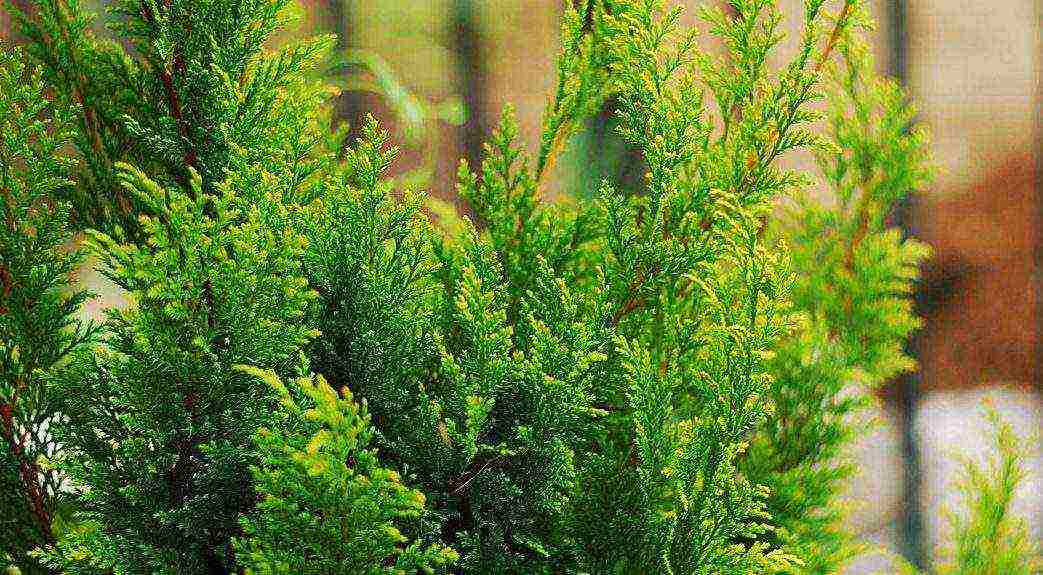
The cypress is often affected by the scabbard or spider mite. Because of such pests, the crown of the bush turns yellow, the leaves begin to fall off. Compact and small bushes are treated with soapy water. It is used a couple of times a week.If the pests have damaged most of the bush, it must be treated with Nuprid. Adult bushes are sprayed with acaricides.
Most often, cypress roots are exposed to rot. If the plant is improperly taken care of, due to frequent watering, the roots begin to suffer from fungal diseases.
If the roots are completely damaged by rot, the plant must be dug up and destroyed. If the disease is detected on time, the bush needs to be dug out, the affected roots should be cut off and treated with a fungicide. After processing, sprinkle the rhizomes with charcoal and plant the bush in a new place with a prepared and well-drained soil.
Shrub wintering
Cypress varieties that endure cold winters in the first three years after planting are recommended to be sheltered for the winter to protect them from the bright sunny winter and spring rays. The bushes are wrapped in burlap or kraft paper.
In the territories of the country with a cold climate, cypress is grown in large tubs, which are brought into the room for the winter.
In the territories of the country where winters are constantly mild, an adult cypress tree hibernates without special shelter.
Breeding features
Cypress is propagated by seed, cuttings or layering. Often the selected variety is propagated by cuttings or layering. Seed propagation of cypress is rarely carried out.
Propagating the plant by seeds
To grow a beautiful tree from a cone, it is important to make a lot of effort and spend a lot of time.
- Remove the seeds from the cone, dry and prepare them for planting. For this, the seeds are subjected to stratification, that is, exposure to cold.
- A couple of months before planting, place the seeds in the sand, and send the tray itself to the refrigerator.
- After two months, place the seeds in a warm room for a couple of days.
- Sow them in a pot, covered with foil until the first shoots appear.
- As soon as the seedlings begin to grow, the film must be removed. The grown seedlings are gradually accustomed to fresh air.
- After a while, they are planted in open ground.
Propagation by cuttings
From the top of the tree, cut a couple of twigs 15 centimeters long. Plant them in light, fertile soil. Cover with plastic wrap and wait for the roots to sprout. After the formation of a strong root system, the cutting is transplanted into open ground.
Cuttings are cut in April, and germination and development is carried out at home until next spring. After a year, the rooted cuttings are planted in a permanent place, where they successfully take root.
Reproduction by layering
Cypress with a creeping, wide crown reproduces by horizontal layers.
- On a horizontal branch, carefully cut off the bark.
- Pull the layer to the ground and sprinkle it with soil.
- Roots will begin to sprout from the incision in a couple of months.
- Carefully separate the cuttings with roots from the main bush and plant them in a new place.
This method is not suitable for trees with narrow crowns, since their branches simply cannot be bent to the ground.
Cypress in landscape design
- You can plant a plant both independently and in groups. Often they make a framing of the territory in the form of a small and neat hedge.
- Cypress is also grown at home in flowerpots, it is only important to create the necessary humidity and coolness for it.
- With the help of a shrub, complex patterns are formed on flower beds.
Now you know how to plant and grow a cypress tree correctly. And also what species it is, and how it reproduces. To grow a really beautiful and lush bush, you need to plant it correctly and take care of it regularly. Care consists of watering, fertilizing, cutting, and protecting against pests and diseases. It is also important to protect bushes from extreme cold and frost in winter.
Rate this article 〉〉〉〉〉
(voted:
, grade:
out of 5)
Share this:
Read more on our website:
Cypress is a striking representative of evergreen trees, which has occupied its niche in the field of landscape design. It looks great when planting a hedge and always fits into any landscape gardening composition.
Cypress: types and varieties
According to various estimates, the cypress family has from 12 to 25 species. At the same time, not all varieties are widely used by humans and not every climate is suitable for growing cypress.
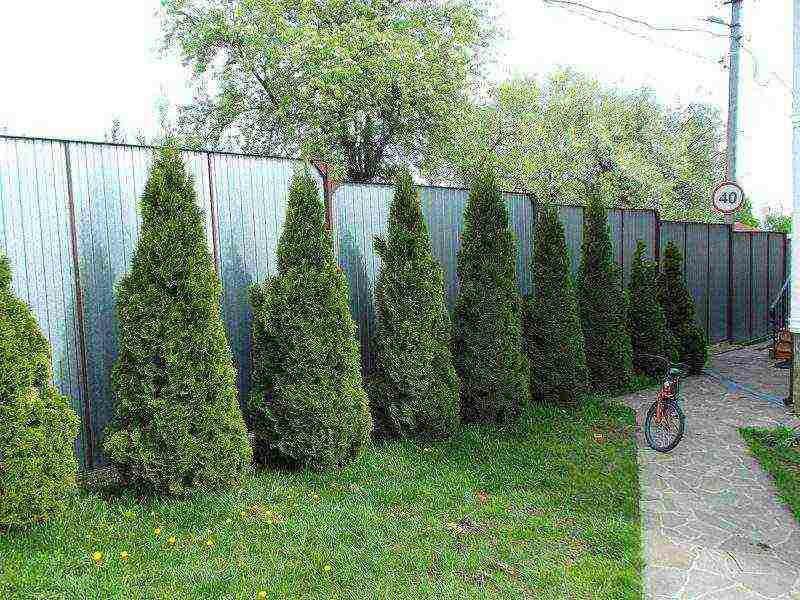
The most common ornamental varieties of this plant include:
- Cypress arizona - grows rapidly and reaches a height of 21 m, withstands frosts down to -20 degrees, is resistant to droughts, loves a lot of light. It has a wide, top-shaped crown with a gray-green tint. The color of the bark depends on the age of the plant: gray is the color of young shoots, dark brown is the color of the old trunk. Cones are large enough - up to 3 cm in diameter. Reproduction can take place by seeds and cuttings. Based on this species, breeders introduced new varieties:
- Ashersoniana - undersized cypress;
- Compact - a shrub with blue-green needles;
- Konica - with a pin-shaped crown and needles of a gray-blue hue (it does not tolerate low temperatures);
- Pyramidalis - with gray needles and a conical crown.
- Evergreen cypress - grows up to 30 m in height, can withstand prolonged drought and short-term frosts down to -20 degrees. It has a narrow pyramidal crown, due to the tightly pressed branches to the tree trunk. Needles with a bluish-green tint. Duration of existence up to 2000 years. Can be grown in urban environments. Scientists have developed more compact varieties of this species so that it can be grown in personal plots:
- Fastigiata Forluselu, Montrosa - dwarf varieties;
- Indica - a variety with a columnar crown;
- Strikta is a variety with a pyramidal crown.
- Mexican cypress - its height can reach up to 40 m, does not tolerate cold and drought. The crown is wide, in appearance it resembles a tent. The needles are dark green, ovoid. Bred varieties:
- Bentama - the branches are located in the same plane, giving the crown a narrow shape, the needles are gray in color;
- Glauka (Blue) - attracts blue needles and, of the same shade, bloom on the cones;
- Tristis (Sad) - the crown takes the form of a column, and flexible branches stretch downward.
When choosing the type and variety of cypress, you should always take into account the conditions in which it will be grown.
Features of growing evergreen trees
Each type of cypress needs special conditions for growth. A common cultivation characteristic for everyone is the choice of planting site.
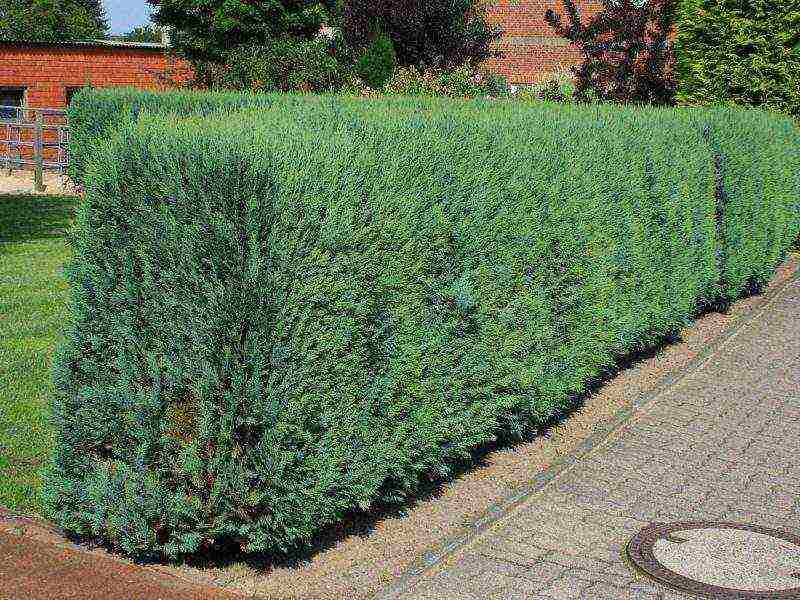
- Cypress loves light, but does not tolerate direct sunlight, so a semi-shaded area would be the best place. It's good if it is still protected from drafts.
- These trees need moisture, but an excess of it is destructive for them. Therefore, the soil must be selected with good drainage properties. The best option would be land with the addition of coniferous humus, peat, sand, or use a litter of rotted leaves.
- The entire cypress family does not tolerate the process of transplanting to a new place. If necessary, this procedure is carried out together with a lump of earth, and after transplanting the tree is tied to a peg.
Planting cypress in open ground

Planting a cypress does not require much effort, but some recommendations should be followed so as not to ruin the seedling.
Planting time frames
The best time to plant will be April. During this period, the earth will have time to warm up and at the same time retain enough moisture. A young seedling will not be exposed to night frosts and will have time to take root before the onset of dry days.
Landing technology
Planting seedlings is always done with a clod of earth so as not to damage the root system. The cypress holes should be twice the size of the rhizome with an earthen lump. The distance between them must be maintained so that the trees do not shade each other.
After moving the seedling into the hole, it is evenly covered with prepared soil and compacted. This is followed by watering.
Important! For a young tree, it is imperative to provide support so that it grows even, without distortion.
Outdoor cypress care
With properly prepared soil and the necessary lighting, cypress is not particularly whimsical to care for. Despite this, some knowledge about caring for it will help to grow a beautiful and healthy tree.
How to properly water and spray
Cypress trees need frequent hydration. Watering is done once a week, but not plentiful. On dry days - doubled.
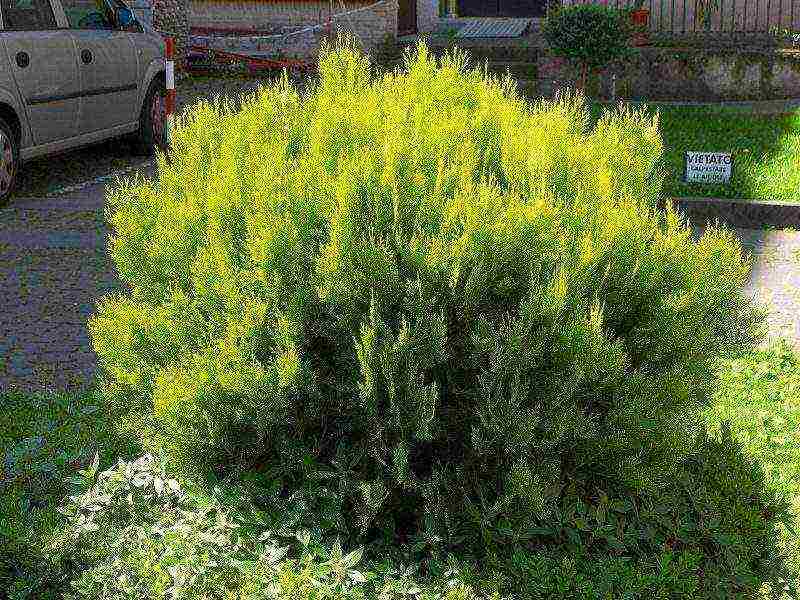
To prevent yellowing of the leaves, with a lack of moisture in the air, a spraying procedure is carried out. It is better to spend it in the morning and evening hours. In hot weather, the spraying intensity increases.
Top dressing and fertilization of trees
In the first 4 years of life, cypress is fed at least 2 times a month. The best feeding option is a mixture of mullein and superphosphate. In the spring-summer period, mineral substances in liquid form will also not interfere with it.
A rooted and matured tree no longer needs such frequent feeding, so they are carried out only twice a year - in spring and early autumn.
Crown formation
Cypress care also includes pruning trees. It is carried out in March, removing all dried, frozen and damaged branches. After this procedure, you can start forming the crown.

The crown of a cypress can be shaped like a pyramid, a cone, or left with a natural look. In this case, at least 70% of the crown should be left on the tree. To preserve the formed crown, in the fall, pruning is carried out that has grown by 30% over the year.
Important! Crown formation begins a year after disembarkation.
Autumn preparation and care in winter
At the end of autumn, the cypress is prepared for wintering.
This process includes the following activities:
- While the ground is not yet very frozen, it is watered abundantly and a layer of sawdust, peat, foliage or needles is poured.
- Young trees (up to 4 years old) must be wrapped with natural materials for the winter. Some varieties, even after this age, require additional protection from frost. To do this, they can be wrapped in foil.
- The crown of the cypress should be wrapped in twine so that the branches do not break from strong winds and heavy snowfall, especially tall varieties.
Plant propagation
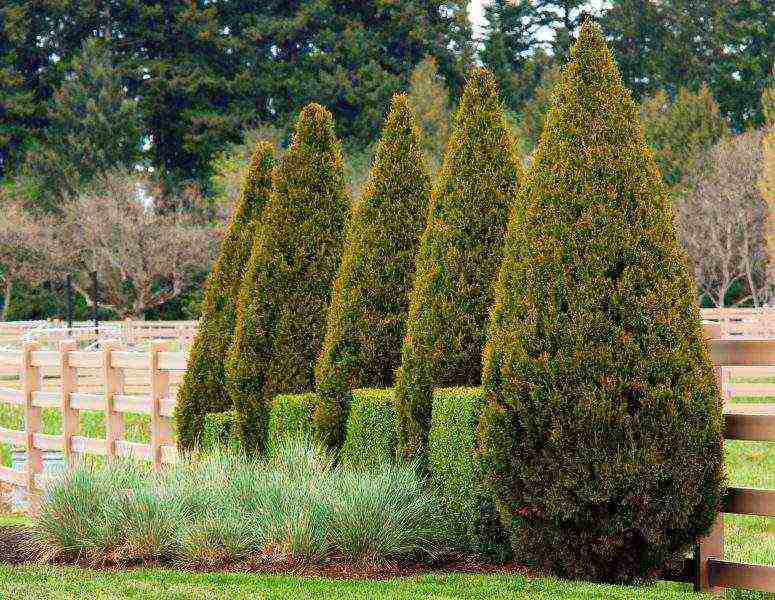
Buying ready-made cypress seedlings is not a cheap pleasure, and the quality of the planting material may not be at the highest level. Therefore, it is worth thinking about the independent propagation of the plant.
Seed breeding method
Seeds collected from cones or purchased from a store are first cold treated. To do this, they are kept in the refrigerator for 3 to 4 months. After that, seeds are sown and watered in a container with prepared soil and drainage (you can use crushed bark). After germination, the seedlings should reach a height of 5 - 6 cm, then they can be planted in separate pots. Watering should be regular so that the ground does not dry out.

Important! Seedlings in such conditions are recommended to withstand a year, after which they can be planted in open ground.
Cypress cuttings
For this method, in mid-April, cuttings up to 15 cm long are cut from the tops of the trees. All leaves are removed from the bottom of the cuttings and soaked in a root solution for a day. Then they are planted in the ground, which is also used for planting seeds, burying it into the ground by 1/3. The stalk takes root within 2 months. For this period, it is covered with a film or a jar, periodically allowing it to breathe, opening for 1 - 1.5 hours. When the rooting process is complete, young trees can be planted in open ground.
Propagation of a tree by layering
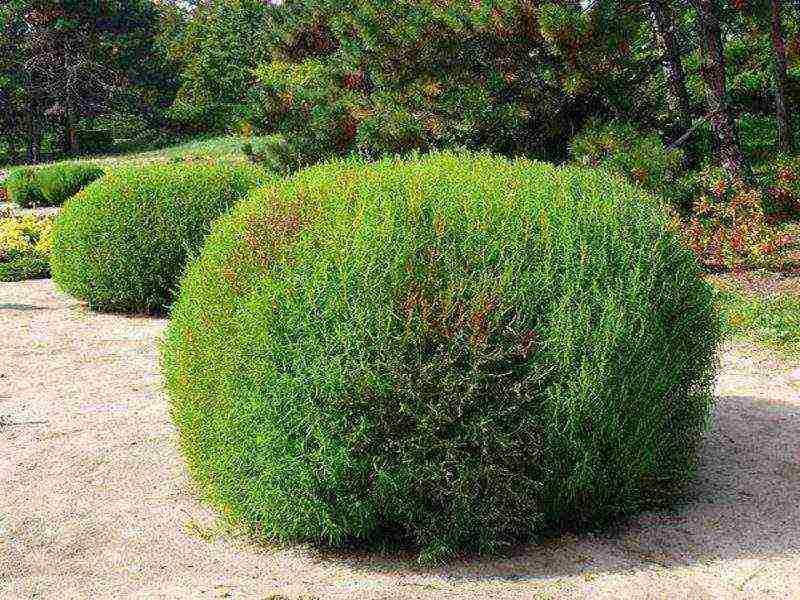
In this case, shoots are used, which are located lowest to the ground. They are bent as much as possible to the ground and an incision is made.This incision is laid tightly on the ground, secured and covered with earth. The apex of the appendix is tied to a support. The taken layering is watered at the same time as the tree. After rooting, the cuttings are transplanted from the mother cypress, but it is recommended to do this in the spring, although the roots appear earlier.
How to deal with diseases and pests
If cypress leaves begin to turn yellow and dry, then this is the first sign of a lack of moisture. The watering and spraying schedule should be revised so that the disease does not destroy the tree.
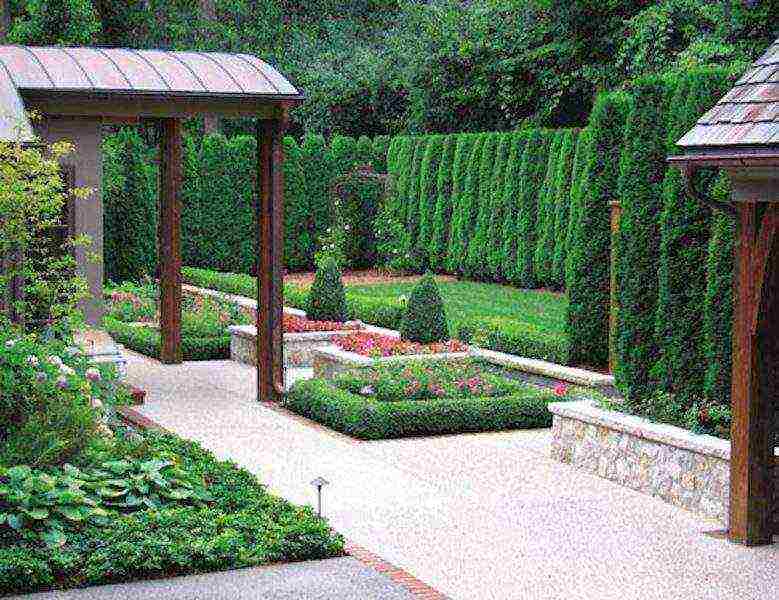
Root rot is considered dangerous, which is the result of an excess of moisture. In this case, the cypress is transplanted to another place, and in case of severe damage, it remains only to throw it away.
Due to the drying out on the cypress, a spider mite (cobwebs on the leaves and between them) and a scabbard (brown spots on the needles and stems) may appear. A sure way to combat such pests is to treat the tree with special insecticides.
Cypress in landscape design
In landscape design, cypress is often used when planting hedges, because it protects well from the wind, or for decorating high fences and blank walls. Some varieties look great in a single planting when decorating rocky corners. Dwarf cypress varieties can decorate any plant composition.
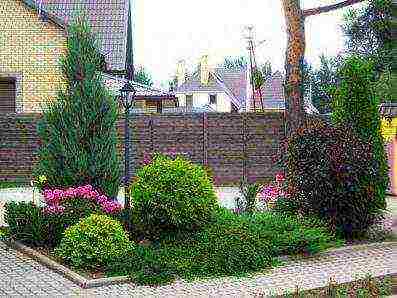
The evergreen handsome cypress tree can decorate any garden, shelter a cozy courtyard from the wind and delight the eye for many years. This will require adhering to some planting and grooming guidelines, which will not take a lot of time and effort.
Cypress (Chamaecyparis) is an evergreen coniferous tree that belongs to the cypress family. This genus unites 7 species, and there are also several hundred cultivars. In natural conditions, the height of such plants in some cases reaches 70 m. The cypress looks very similar to the cypress, so these plants are often confused. Cypress differs from cypress in that its branches are smaller and flatter. This tree also has a pyramidal crown, which is very similar to the thuja. The native land of the cypress is North America and East Asia. It began to be cultivated at the end of the 18th century. Cypress is cultivated both in the garden and at home.
Features of the cypress

Native to North America are such species of this plant as: Nutcan cypress, thuve and Lawson. Natives of East Asia are such species as: dull cypress, mourning, pea and Formosan. In the wild, these plants are very tall and have small, lush, scale-like needles, as well as round buds that are much smaller than cypress and contain fewer seeds. By the way, Japanese and North American species of this plant have a higher frost resistance compared to cypress. So, they can winter in mid-latitudes without shelter. But on dry periods in the summer, such plants react more negatively than cypress.
Such a tree has a cone-shaped crown, while the long branches are drooping or outstretched. The covering of the trunk surface is light brown or brown bark, which consists of small scales. Pointed, tightly pressed leaf plates can be dark green, smoky blue, greenish yellow, or green. Young specimens have needle-shaped leaf plates, and adults have scale-like ones. The diameter of the cones is 1.2 centimeters, while the seeds ripening in them are viable already in the year of planting the seedling. Recently, Japanese, European and American breeders have created more than two hundred cultivars, which differ in size, shape, crown color, etc.
Planting a cypress
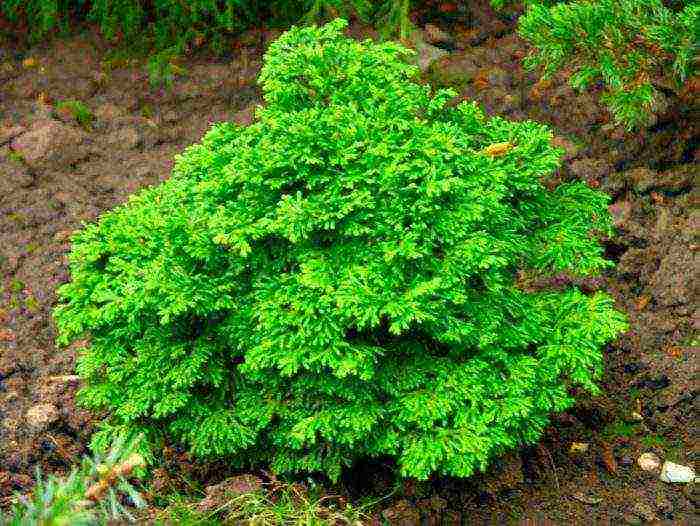
What time to plant
For planting a cypress, it is recommended to choose a site that is located in partial shade, but at the same time it is necessary to avoid lowlands, since cold air stagnates in them. Species with light blue or green needles need relatively less light than those with greenish-yellow needles. The soil on the site should be saturated with nutrients, well-drained is best if it is loamy and in no way calcareous. A seedling is usually planted in the spring in April, after the soil warms up well, but it is recommended to prepare a hole for planting in the autumn, so the soil will have time to settle properly. To do this, you need to make a hole, the depth of which should be 0.9 m, and the width - 0.6 m. At its bottom, a drainage layer with a thickness of 0.2 m should be made, which should consist of sand and broken brick. Then the hole should be filled ½ part with a soil mixture consisting of humus, turf, sand and peat (3: 3: 1: 2). In winter, this soil mixture will rot and settle, and with the onset of the spring period it will warm up relatively quickly. In the event that you will plant more than one cypress seedling, then it should be borne in mind that the distance between them should be at least 100 centimeters, and preferably more. This is because in a given plant, the root system grows horizontally.
How to plant
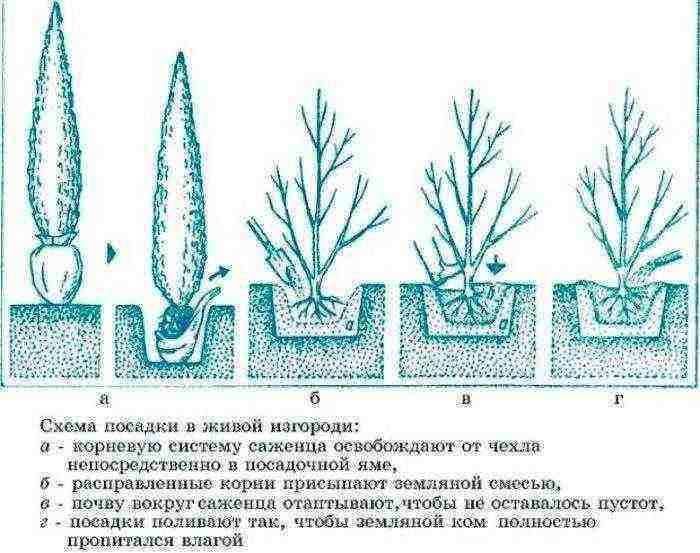
Most often, ready-made cypress seedlings are planted, which can be bought in a garden nursery or a special store. Before planting a seedling, you need to water the hole well for planting, and also shed a clod of plant earth using a root solution for this (1 package of product for half a bucket of water). After that, the plant must be lowered into the center of the hole and gradually covered with soil mixture (see its composition above), combined with 0.3 kg of nitroammofoska. After planting, the root collar of the seedling should be 10–20 centimeters above the soil surface, because the soil will surely settle. The planted tree must be well watered. After the soil has settled, it will be necessary to add more soil, so that the root collar is flush with the ground surface on the site. Then the trunk circle should be covered with a layer of mulch, and the cypress tree should be tied to the support.
Cypress care

First of all, you need to pay attention to the fact that this plant needs systematic watering, which should be carried out once a week, about a bucket of water is taken for one bush. However, if there is a long dry and hot period, then the frequency and abundance of watering should be increased. An adult plant must be sprayed abundantly once every 7 days, and young specimens are sprayed daily. In the event that the surface of the trunk circle is covered with a layer of mulch (peat or wood chips), then watering should be done after the top layer of soil dries up. In the event that the trunk circle is not sprinkled with mulch, then every time after the tree is watered, it is necessary to weed and loosen the soil surface by about 20 centimeters in depth.
A couple of months after planting, the seedling must be fed with a complex fertilizer, while the concentration of the nutrient solution should be half the amount recommended for an adult specimen. Top dressing of adult specimens is carried out 1 time in 2 weeks until the second half of July, while using a complex mineral fertilizer. Experts advise choosing a fertilizer such as Kemira for conifers, while before watering the plant, from 100 to 150 grams of a substance is scattered over the surface of the trunk circle, which must be embedded in the soil. From the second half of the summer period, it is necessary to stop feeding the tree, otherwise it will not be able to properly prepare for wintering.
Transfer
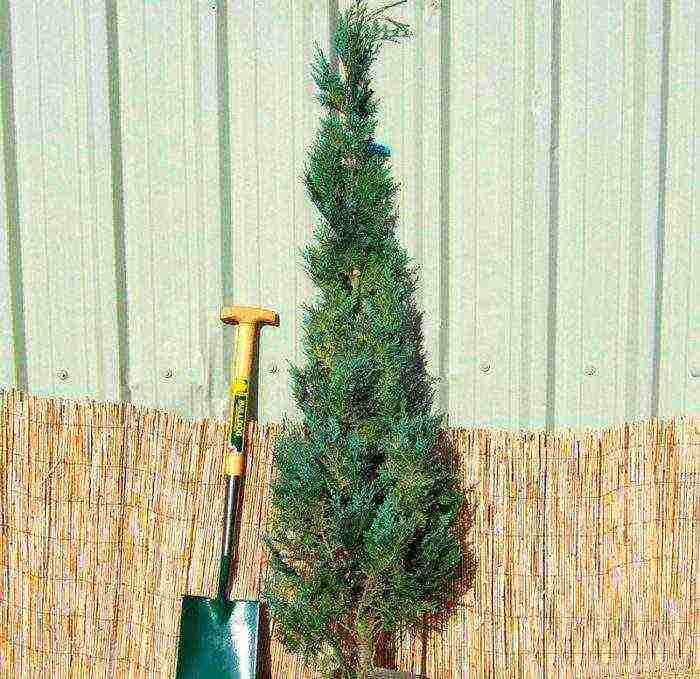
Transplanting this tree is also recommended in the spring.The rules for transplanting a cypress tree are very similar to those used when planting a seedling in open ground. When you dig up a tree, be sure to keep in mind that it has a branched horizontal root system.
Pruning

This plant also needs systematic pruning. In early spring, you need to cut off the tips of the stems that have suffered from frost, as well as cut off old, injured or dried branches. Together with sanitary pruning in spring, it is recommended to produce shaping. To do this, it is enough to maintain the natural conical or pyramidal shape of the tree crown. Remember that no more than 1/3 of the green mass should be cut off in one cut. When the season of active growth in autumn is over, it will be necessary to cut off 1/3 of the growth of this year, while it is imperative to preserve the existing shape of the crown. There should be no bare branches on the tree, because after some time they will dry out anyway. It will be possible to start forming the crown 12 months after planting or transplanting the plant.
Diseases and pests
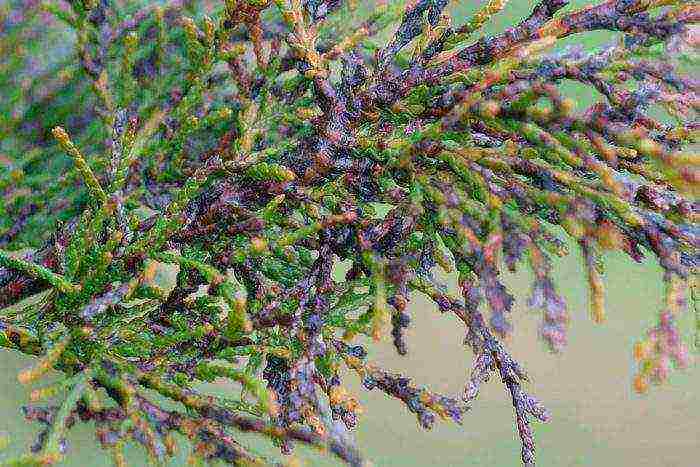
Cypress trees are highly resistant to diseases and harmful insects. However, sometimes scale insects and spider mites can settle on such a tree, and root rot can also appear. If spider mites settle on a plant, then it will turn yellow, and its needles will fly around. To get rid of such pests, it is recommended to treat the tree several times with an interval of 7 days with an acaricidal agent (Neoron, Apollo or Nissoran). The scale insects suck the vegetable juice out of the cypress, as a result of which it begins to dry, and its needles fall off. To destroy these pests, it will be necessary to treat the plant with nuprid, and in most cases, several sprays are required to achieve a lasting effect. In the event that the tree is very infected, then it is recommended to dig it up and burn it, otherwise the scale insects can move to other plants.
If there is stagnation of water in the soil, this will lead to the development of such a fungal disease as root rot. A good prevention against this disease is a thick drainage layer in the planting pit, which is made during planting. In the event that the disease is not detected in time, it can cause the death of the tree. It is recommended to dig up the affected plant, freeing its roots from the ground, they must be cut to healthy tissue. Then the root system should be sprayed with a fungicide, and the tree itself should be planted in another place that suits it best for agronomic requirements. In the event that the entire root system of a tree is affected, then it will have to be burned.
Cypress propagation
Such a tree can be propagated by seeds, cuttings and layering. As a rule, only wild cypress species are propagated by seeds. The most reliable propagation method is cuttings, and the simplest is layering.
Growing from seeds
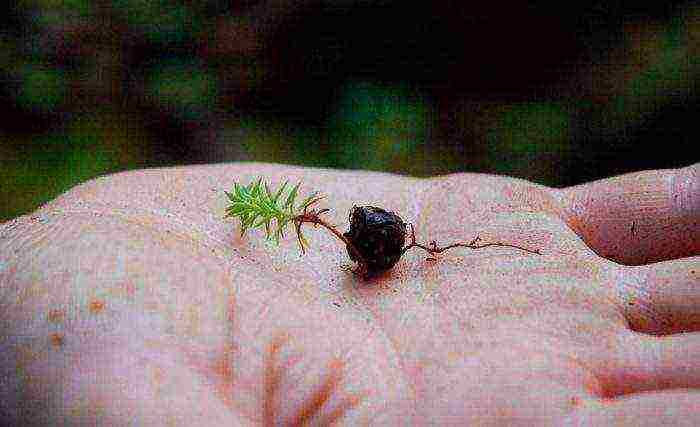
If the seeds are collected correctly and dried well, then their germination capacity will remain for 15 years. To increase the percentage of seed germination, they must be stratified. Seeds must be sown in a container or box filled with light soil, then the container must be taken outside, where it is buried in the snow. The seeds will be there until the onset of the spring period. If you wish, you can put the box with seeds in the refrigerator on the vegetable shelf. When spring comes, containers with seeds should be brought indoors, where they should be placed in a warm (from 18 to 23 degrees), lighted place, which is protected from direct sunlight. If everything is done correctly, then the first shoots will seem fast enough. Seedlings must be provided with moderate watering, in the event that the seedlings are dense, then the plant must be dived.After a positive temperature is established outside, the seedlings will need to be transferred to fresh air every day, so that they can harden. Fortified seedlings must be planted in open soil, for this you need to choose a place located in partial shade and with loose soil. There the plants will spend the winter under cover. But with this method of reproduction, it is worth considering that seedlings very rarely retain the varietal characteristics of the parent plants.
Cuttings
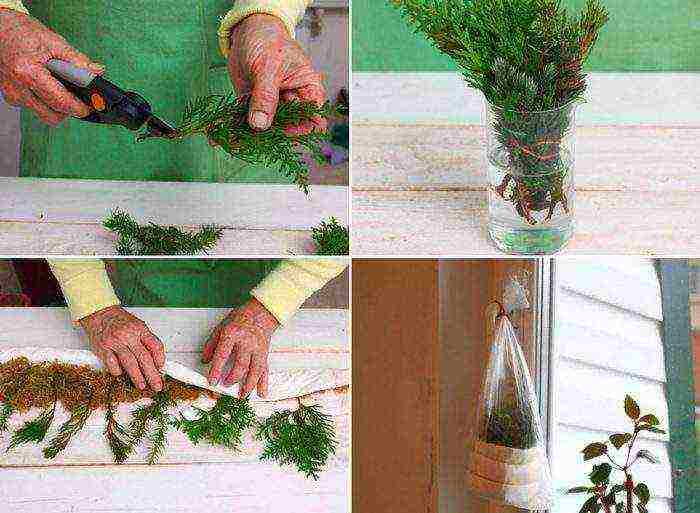
Cuttings are harvested in the spring. Apical cuttings are cut from young lateral stems. The length of the cuttings can vary from 5 to 15 centimeters. The lower part of the cuttings must be freed from the needles, and then they are planted for rooting in pots filled with a soil mixture, which includes perlite and sand (1: 1); it is also recommended to add a little small coniferous bark to this mixture. After that, the container must be covered with a polyethylene bag. If the air humidity is constantly maintained close to 100 percent, then the cuttings will give roots in 4-8 weeks. Cuttings, if desired, can be planted immediately in open soil, while they must be covered with plastic bottles, from which the necks should be cut off in advance. Cuttings planted in open soil can survive the winter without shelter, but only if they develop normally. If the rooting of cuttings is extremely slow, then they will have to winter indoors.
How to propagate by layering

In this way, the creeping or prostrate forms of this plant can be propagated. To do this, you need to choose a stem that grows very close to the surface of the soil. An incision must be made on its outer side, in which a small stone must be placed. This is to ensure that the incision does not close. Then the shoot must be laid on the surface of the soil with an incision down and fixed with a bracket. The upper part of the stem should be tied to a support, and at the same time the place of the incision should be covered with a layer of soil. During the period of active growth, the cuttings should be regularly watered together with the parent tree. When the roots grow in the layer, it should be cut off from the mother plant and planted in a permanent place. It is recommended to transplant in the spring, despite the fact that the cuttings can grow roots in the fall.
Cypress in winter
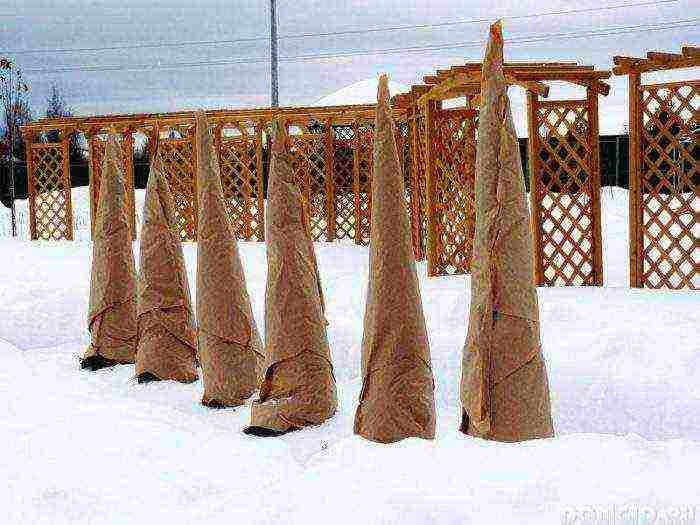
Preparation for wintering
Those varieties and types of cypress that are winter-hardy must be covered for the first 3 or 4 years after planting in open ground. This should be done not in order to protect the plant from frost, but to protect it from the excessively bright sun in winter and spring. To cover the tree, it should be wrapped in acrylic, kraft paper, burlap or lutrasil.
Wintering
In Siberia, the Urals, as well as in the Moscow region, such a plant is not cultivated in open ground. As a rule, it is planted in a large tub, which is carried outside in the summer, and brought back into the room in the fall. In those areas where winters are not so harsh (Moldova, Ukraine, Crimea), cypress is grown directly in the open ground, and it is not sheltered for the winter.
Types and varieties of cypress with photos and names
Below will be described 7 types of cypress, as well as their cultivars, which are most popular with gardeners.
Pea cypress (Chamaecyparis pisifera)
The homeland of this species is Japan. In the wild, such a tree can reach a height of about 30 m. The brown bark has a reddish tint, while the openwork crown has a wide conical shape. The outstretched branches are arranged horizontally. The needles are bluish-gray in color, and the cones are brownish-yellow, and their diameter is only 0.6 centimeters. Popular cultivars:

- Boulevard (write Boulevard correctly). The height of the tree can be up to 5 m and even more. The crown shape is a pin.Bluish-silver awl-shaped needles are bent inward, while in length they can reach 6 centimeters. The seedlings of such a cultivar are characterized by extremely slow growth. However, as the tree matures, its growth accelerates, with 10 centimeters of growth added every year. This plant has low winter hardiness, so it is recommended to grow it in regions with mild winters.
- Phillifera... The height of this tree can reach up to 5 m. The shape of the crown is broadly conical. Hanging or spaced stems droop strongly towards the ends. It does not grow very quickly. Scaly needles are dark greenish-gray in color. Cultivated since 1861.
- Nana... It is a low-growing, slow-growing shrub. Its squat crown is cushion-shaped. Such a tree, when it turns 60 years old, can have a height of only 0.6 m, while it will reach 1.5 m in diameter. Scale-like small needles are painted blue. Cultivated since 1891.
Lawson's cypress (Chamaecyparis lawsoniana)
This species is native to North America. In the wild, a tree can reach a height of 70 m. The crown has a narrow conical shape, which expands downward, as a rule, the top of such a tree tilts to one side, and the branches are able to descend to the surface of the ground. The brownish-red thick bark is not intact; it cracks into lamellas. The upper surface of the green needles is glossy. Pale brown buds have a bluish bloom, and their diameter varies from 8 to 10 centimeters. Popular varieties:

- Lawson Elwood... A tree with a cone-shaped crown, its height can reach up to 3 m. Straight branches are slightly drooping. The blue needles are thinner than the original. There are different forms: Elwoody Gold, Elwoody Pidgemy, Elwoody White, Elwoody Pillar.
- Blue Seprise... This dwarf tree can reach 3.5 m in height. The dense crown has a narrow pyramidal shape, and it reaches 1.5 m in diameter. The red-brown bark often cracks. Small needles are colored bluish-silver.
- Loveson Flatchery... It can reach a height of 8 m. This tree has a columnar crown, while the branches are directed upwards. With the onset of autumn, green or light blue branches have a purple hue. It has been cultivated since 1911.
Blunt cypress (Chamaecyparis obtusa)

The birthplace of this plant is Japan. In natural conditions, it can reach a height of 50 m. The trunk girth can reach a couple of meters. The smooth bark is pale brown. The stems branch many times and very densely. The tops hang a little. The front surface of the needles is green or greenish-yellow glossy, and on the surface of the purl there are clearly distinguishable stomatal stripes of white color. Scale-like leaves are pressed to the stems. Cultivated since 1861 Popular varieties:
- Albopicta. The height of such a dwarf cultivar can reach 200 centimeters. There are many branches that run horizontally. The tips of the branches are whitish-yellow, and the needles are colored green.
- Sanderi. This dwarf form is very slow in growth. Branches of uneven thickness are arranged horizontally, and can be straight. Fork-shaped branches. Greenish-blue needles in winter change their color to violet-purple.
- Contorta. Such a tree has a pin-shaped crown, and in height it reaches 200 centimeters. The dense needles are pale green.
Thuate cypress (Chamaecyparis thyoides)

Originally from North America. In the wild, the height of such a tree can reach 25 m. The trunk has a diameter of about 100 centimeters. The crown has a narrow conical shape. The color of the bark is brownish red. The needles are painted in a pale blue or dark green color, if you grind it, you can feel the characteristic smell. Cultivated since 1736. Popular forms:
- Konica.This dwarf slow-growing tree has a pin-shaped shape. There are straight blunt branches. The subulate needles are bent downward.
- Endelaiensis. This dwarf keeled tree can reach a height of 2.5 m. The branches are short and dense. The branches are straight and slightly fan-shaped. The pairwise opposite needles are colored greenish-blue.
Nutkan cypress, or yellow (Chamaecyparis nootkatensis)
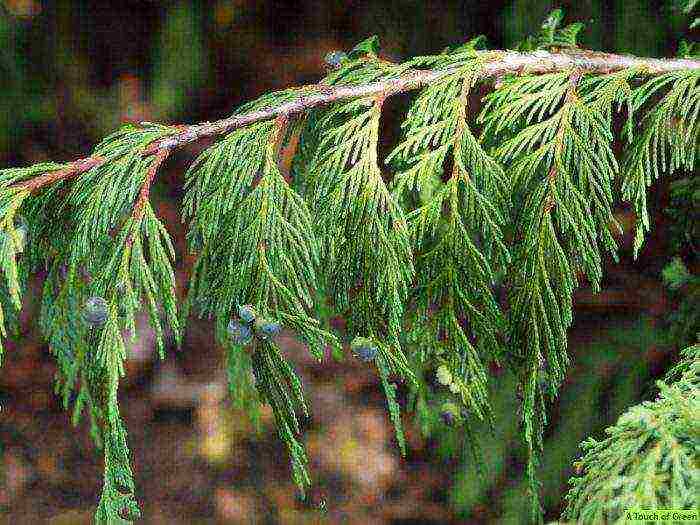
In the wild, it can be found along the Pacific coast. The height of such a plant can reach 40 m. There is a lush graceful crown. The tops of the branches create a fan-shaped pattern. The brownish gray bark is flaky. If you grind the dark green needles, then you can smell a not very pleasant smell. The shape of the cones is spherical. The most popular forms are:
- Weeping (Pendula). The height of such a plant is about 15 m, it is resistant to smoke and drought. The tops of the stems are drooping. Glossy small needles have a dark green color.
- Glauka. The height of the tree can vary from 15 to 20 m. The crown of the narrow conical shape reaches about 6 m in diameter. The brownish-gray bark is prone to cracking. Scaly prickly needles are colored greenish-blue.
Gardeners also cultivate such types of cypress as Formosian and mourning and their cultivars.
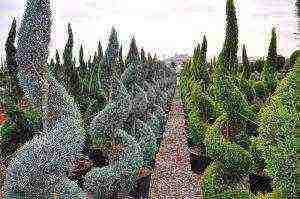 Cypress is one of the brightest representatives of evergreen trees. The natural habitat of this coniferous plant is the warm countries of Asia and the southern states of North America. Therefore, growing it in the harsh conditions of central Russia is fraught with the risk of significant freezing of the crown and complete freezing of the root system. But in more southern regions, it may well become a graceful garden accent. Many people grow cypress as a houseplant. In this article, we will focus on issues related to planting and caring for cypress trees in the garden, in open ground.
Cypress is one of the brightest representatives of evergreen trees. The natural habitat of this coniferous plant is the warm countries of Asia and the southern states of North America. Therefore, growing it in the harsh conditions of central Russia is fraught with the risk of significant freezing of the crown and complete freezing of the root system. But in more southern regions, it may well become a graceful garden accent. Many people grow cypress as a houseplant. In this article, we will focus on issues related to planting and caring for cypress trees in the garden, in open ground.
The cypress forms a very neat decorative crown with scaly needles. Neat rounded bumps serve as an additional decoration. Wild cypress reaches a height of several tens of meters, depending on the species, forms a pin-shaped, pyramidal or spreading crown of different shades of green. Along with tree-like forms, there are also shrubs. Breeders have bred decorative dwarf varieties and shrubs with original color of needles, which look spectacular in design compositions. Cypress on the site of a country house is a symbol of the high status of the owners, like solid wood furniture in the living room.
Cypress propagation: seeds and cuttings
It is quite problematic and expensive to purchase ready-made cypress seedlings, while no one can guarantee the high quality of such planting material. Therefore, independent reproduction remains relevant.
Seeds of a cypress of full maturity have a fairly high germination capacity, but they need to be prepared before sowing. Cypress forms the first cones in adulthood after 4-5 years of cultivation. Male and female cones appear on one plant. Cones ripen only in the second year, therefore, for harvesting seeds, you need to take not young green cones, but mature brown-gray ones.
The collected seeds must be stratified by placing them in the refrigerator for 3 - 4 months. The day before planting, the seeds are soaked overnight (at least 10 hours) in warm water. Sowing is carried out in a special mixture for conifers, which can be bought at any flower shop. A seedling box can be used as a container. A drainage layer of chopped bark of deciduous trees is laid at the bottom of the box, and then the soil mixture is poured.
Sowing maintenance consists of regular watering, the substrate should always be moistened. Seedlings appear no earlier than a month later. Seedlings grow slowly.When they reach a height of 6 cm, it is necessary to plant them in separate pots of small diameter. When transplanting, you need to ensure that the root collar does not remain buried in the substrate. The first year, seedlings are grown as a houseplant, but for the winter it is better to place the pots in cooler places (veranda of a private house, loggia).
In the second year, grown seedlings can be planted in open ground, but two or three years of room maintenance is also allowed to obtain a stronger and grown plant.
Cypress cuttings can take place in 3 periods:
- from mid to late April;
- end of June;
- first week of September.
For grafting, you should take branches from the very top, cutting them off with a "heel". Before soaking the cuttings in the growth regulator, they need to remove the lower modified needles. Processing lasts a day, after which the cuttings are planted in a substrate similar to that used for sowing seeds. The only difference is that a thin layer of wet river sand is laid on top. The cuttings are buried 1/3 of their length and covered with glass or a thick film. It is recommended to air the disembarkation every few days for an hour. Rooting lasts about 2 months, after which a full-fledged seedling can be planted in open ground.
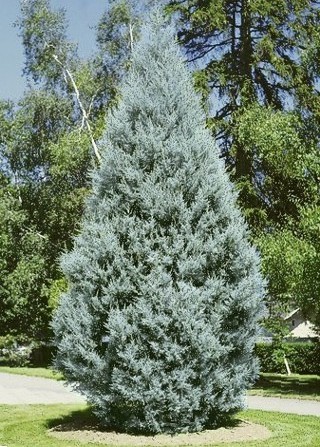
Arizona cypress - Cupressus arizonica 'FASTIGIATA'
Planting a cypress: site selection and soil preparation
Cypress does not tolerate direct sunlight, and in the shade it stretches strongly, therefore, areas in partial shade are ideal for its growth. It does not tolerate waterlogging, but needs frequent watering, so it is better to choose soils with a good ability to drain excess moisture. Otherwise, each species has its own specific requirements for growing and care conditions.
When preparing a pit for planting, it is advisable to use a substrate from soil and coniferous humus. Alternatively, a mixture of peat, sand, turf and rotted leaf litter is suitable. Cypresses react painfully to transplanting to a new place, therefore the seedlings are transferred along with an earthen lump. After planting, the young stem is tied to a pre-hammered peg.
Evergreen cypress - Сupressus sempervirens
Adult plant care
In the first years of life, cypress needs frequent feeding (every 2-3 weeks). A mixture of mullein (5 kg of manure in 20 liters of water) and superphosphate is ideal for these purposes. After 4 years of life, the need for fertilizing falls, and it will be sufficient to apply fertilizer in spring and autumn at the end of the season.
Watering should be frequent, but not plentiful; by autumn, their frequency is reduced. On hot days, the cypress needs evening sprinkling, otherwise its crown loses its decorative effect due to the appearance of yellowed needles.
Formative pruning, as a maintenance measure, is carried out in early spring while cutting dry and broken branches at the same time.
For the winter, the trunks of adult plants are additionally insulated with needles, spruce branches or sawdust. Up to 4 years of age, the cypress is completely covered.
In the open field, cypress is resistant to diseases and pests, unlike indoor cultivation.
Lusitanian or Mexican cypress - Сupressus lusitanica
Cypress in landscape design
Cypress does not tolerate the tightness and gas pollution of city parks and roadside plantings. But he is good at decorating the territory of sanatoriums, country cottages and recreation centers.
The most popular in landscape design are Californian cypresses (create a shield from the wind), Mexican cypresses (creating a hedge), large-fruited cypress and Kashmir cypress (graceful in single plantings). Many dwarf varieties are great for creating compositions.
How useful was the information for you?
votes (
, rating:
out of 5)

